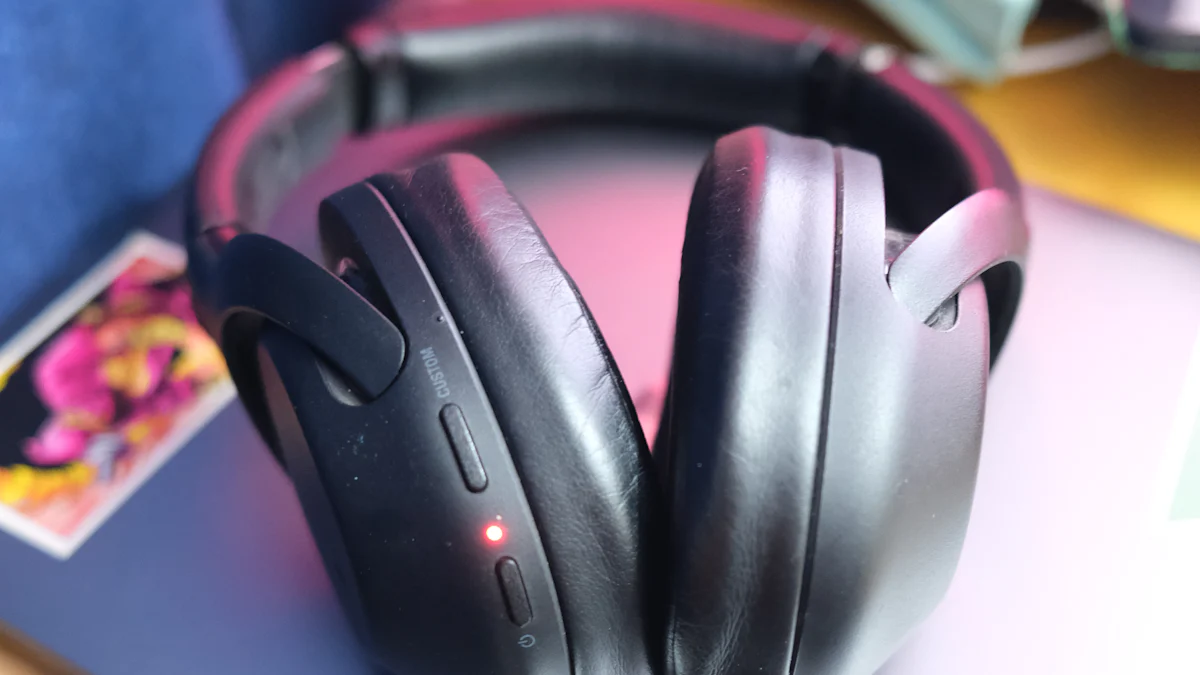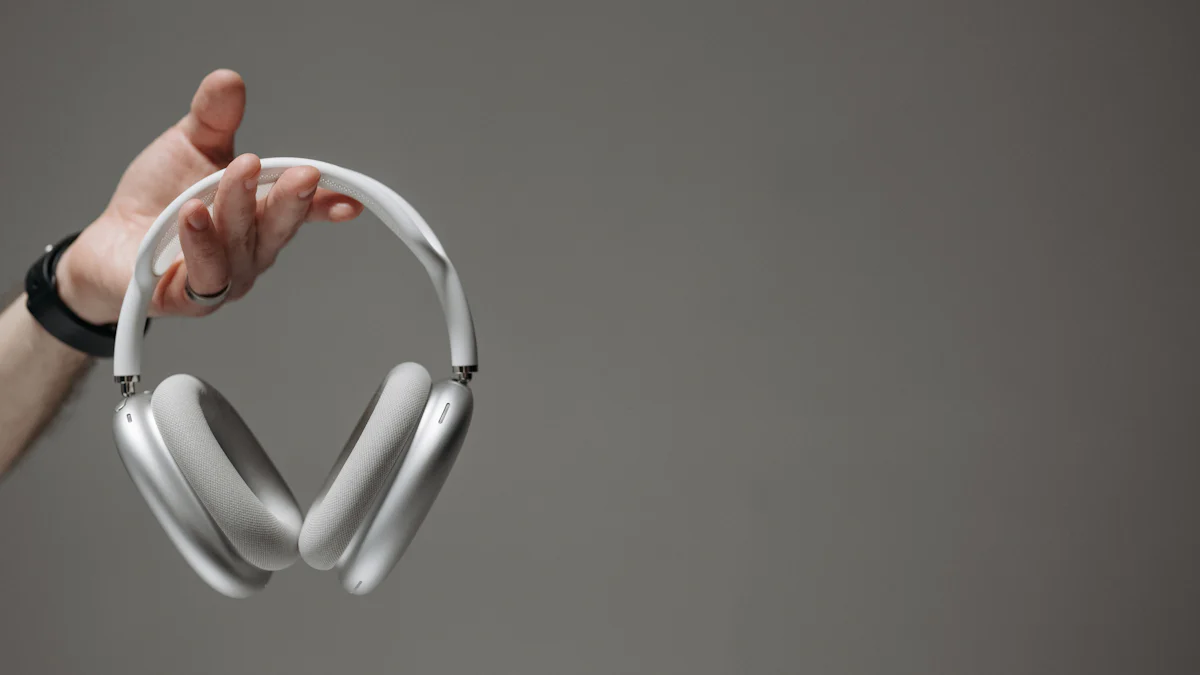Essential Features of Noise-Cancelling Headsets

Choosing the right noise-cancelling headset can transform your audio experience. Whether you're working in a bustling office or enjoying music at home, a quality headset with a noise-cancelling microphone headset for reducing background noise in calls is essential. When buying noise-canceling headphones, consider these key features:
- Active Noise Cancellation (ANC): Blocks out unwanted sounds.
- Comfort and Fit: Ensures long-lasting wearability.
- Sound Quality: Delivers clear and immersive audio.
- Battery Life: Supports extended use without frequent charging.
These factors will guide you in buying the perfect headset that suits your needs.
Types of Noise Cancellation

When you're on the hunt for the perfect noise-cancelling headphones, understanding the types of noise cancellation is crucial. Let's dive into the two main types: Active Noise Cancellation (ANC) and Passive Noise Cancellation.
Active Noise Cancellation (ANC)
Active noise cancellation (ANC) is a game-changer in the world of audio. It uses advanced technology to create a serene listening environment. How does it work? Well, ANC headphones, like the popular Bose QuietComfort Ultra, employ internal microphones and a digital signal processor (DSP). These components detect external sounds and generate sound waves that effectively cancel them out. This process neutralizes unwanted noise, allowing you to enjoy your music or calls without distractions.
ANC headphones are particularly beneficial in noisy environments, such as airplanes or busy offices. The Bose QuietComfort Ultra Headphones are a prime example of this technology in action. They offer a superior listening experience by significantly reducing background noise. With ANC, you can immerse yourself in your audio world, whether you're listening to music, watching a movie, or taking an important call.
Passive Noise Cancellation
On the other hand, passive noise cancellation relies on the physical design and materials of the headphones to block out sound. This type of cancellation doesn't use any electronic components. Instead, it focuses on creating a seal around your ears to prevent external noise from entering. The Bose QuietComfort Ultra Earbuds excel in this area, providing a snug fit that naturally reduces ambient noise.
Passive noise cancellation is effective for blocking out high-frequency sounds, like chatter in a coffee shop or the hum of an air conditioner. It's a simple yet effective way to enhance your listening experience without relying on technology. Plus, passive noise cancellation doesn't require batteries, making it a convenient option for those who prefer a more straightforward approach.
Form Factor
When choosing noise-cancelling headphones, the form factor plays a crucial role in your overall experience. Let's explore the three main types: In-ear Headsets, Over-ear Headphones, and On-ear Headphones.
In-ear Headsets
In-ear headsets, often referred to as Earbuds, fit snugly inside your ear canal. They offer excellent portability and are perfect for on-the-go use. You can easily slip them into your pocket or bag without any hassle. These headphones provide great passive noise isolation by creating a seal within your ear, which helps block out external sounds. This makes them ideal for commuting or working in noisy environments.
However, some people find Earbuds uncomfortable for extended periods. Depending on your ear shape, they might not stay in place during vigorous activities. If comfort is a priority, you might want to try different models to find the best fit for your ears.
Over-ear Headphones
Over-ear headphones are known for their plush ear cups that envelop your entire ear. This design offers superior sound isolation and a more immersive audio experience. The large drivers in these headphones deliver excellent sound quality, with deep bass and clear highs. If you're a music enthusiast or someone who values sound quality, over-ear headphones are a fantastic choice.
These headphones are also comfortable for long listening sessions, as the ear cups rest outside the ear canal. However, they can be bulkier than other types, making them less portable. Depending on your lifestyle, you might find them more suitable for home or office use rather than travel.
On-ear Headphones
On-ear headphones sit directly on your ears, providing a hybrid design between in-ear and over-ear models. They are more compact than over-ear headphones, making them easier to carry around. However, they don't cover your ears entirely, which can affect sound quality and passive noise cancellation (PNC).
While on-ear headphones offer a decent balance of portability and sound quality, they might not provide the same level of noise isolation as over-ear models. Depending on your needs, they can be a good compromise if you want something lightweight yet effective.
Sound Quality
When it comes to headphones, sound quality is a top priority. You want your music, podcasts, or calls to sound crisp and clear. Let's explore why sound quality matters and what factors influence it.
Importance of Sound Quality in Headphones
Sound quality can make or break your listening experience. Imagine listening to your favorite song with muffled vocals or distorted bass. Not fun, right? High-quality sound ensures you hear every note and beat as intended. It enhances your enjoyment and lets you fully immerse yourself in the audio. Whether you're a music lover or someone who uses headphones for work, good sound quality is essential.
Scientific Research Findings:
- A study on Evaluation of Sound Quality in Headphones highlights that sound quality involves aspects like build quality, comfort, and noise-canceling performance. These elements contribute to a richer audio experience.
Factors Affecting Sound Quality
Several factors play a role in determining the sound quality of headphones. Understanding these can help you make an informed choice:
-
Frequency Response Consistency: This refers to how well headphones reproduce different frequencies. A balanced frequency response ensures that bass, midrange, and treble are all clear and distinct. You don't want any part of the audio spectrum to overpower the others.
-
Soundstage Qualities: Soundstage refers to the perceived spatial location of sound sources. A good soundstage makes you feel like you're in the middle of a live concert, with instruments and vocals coming from different directions. This adds depth and realism to your listening experience.
-
Mid-range Sonic Signature: The mid-range is where most vocals and instruments reside. A well-defined mid-range ensures that voices sound natural and instruments have clarity. This is crucial for genres like classical or jazz, where detail matters.
-
Noise-Canceling Performance: Effective noise-canceling technology can significantly enhance sound quality by reducing unwanted background noise. According to a study on Influence of Noise-Canceling Technology, activating noise-canceling features reduces sound pressure levels, allowing you to enjoy your audio at lower volumes without sacrificing clarity.
-
Build Quality and Comfort: While not directly related to sound, the build quality and comfort of headphones can affect your perception of sound quality. Comfortable headphones let you listen for longer periods without fatigue, enhancing your overall experience.
By considering these factors, you can choose headphones that deliver excellent sound quality. Remember, it's not just about the specs; it's about how they come together to create an enjoyable listening experience.
Comfort and Fit

When it comes to choosing the right headphones, comfort and fit are just as important as sound quality. You might wear them for hours, whether you're gaming, working, or simply enjoying your favorite tunes. Let's explore why comfort matters and what factors influence the fit of your headphones.
Importance of Comfort for Prolonged Use
Imagine settling in for a long gaming session or a day at the office with uncomfortable headphones. Not fun, right? Comfort is crucial for prolonged use. You want headphones that feel like a natural extension of yourself, not a burden. Comfortable headphones let you focus on your task or entertainment without constant adjustments or discomfort.
Testimonial: "The Razer BlackShark V2 Pro (2023) isn't a freakish battery pack that happens to play audio — It's a genuinely amazing wireless gaming headset that ticks every box and excels in every category that just happens to last a ridiculously long time."
This quote highlights how a well-designed headset can enhance your experience. You won't have to worry about discomfort or frequent charging interruptions. Instead, you can immerse yourself in your activities without distractions.
Factors Influencing Fit
Finding the perfect fit involves considering several factors. Let's break them down:
-
Headband Adjustability: Look for headphones with an adjustable headband. This feature ensures a snug fit on different head sizes. You don't want them too tight, causing headaches, or too loose, constantly slipping off.
-
Ear Cup Design: The design of the ear cups plays a significant role in comfort. Over-ear headphones with plush padding provide a gentle embrace around your ears. This design helps in passive noise cancellation by creating a seal that blocks out external noise. On-ear models, while more compact, might not offer the same level of noise isolation.
12 3. Material Quality: Pay attention to the materials used in the headphones. Soft, breathable materials prevent sweating and discomfort during extended use. High-quality materials also contribute to the durability of the headphones, ensuring they last longer.
-
Weight: Lightweight headphones reduce strain on your head and neck. You can wear them for hours without feeling weighed down. This is especially important if you plan to use them for long periods.
-
Earbud Fit: If you prefer Earbuds, finding the right fit is essential. They should sit comfortably in your ear canal without causing irritation. Many models come with different ear tip sizes to help you achieve the perfect fit. A secure fit enhances passive noise isolation and prevents them from falling out during movement.
By considering these factors, you can find headphones that offer both comfort and a secure fit. Remember, the right pair will let you enjoy your audio experience without any discomfort or distractions.
Battery Life and Charging
When you're picking out wireless headphones, battery life is a big deal. You don't want your headphones dying in the middle of your favorite song or an important call. Let's dive into why battery life matters and explore the different charging options available.
Importance of Battery Life in Wireless Headphones
Battery life can make or break your headphone experience. Imagine you're on a long flight or a road trip, and your headphones run out of juice. Not fun, right? You need headphones that keep up with your lifestyle. Some models, like the Anker Soundcore Q35, offer up to 40 hours of use on a full charge. That's a lot of listening time! Plus, a quick five-minute charge can give you four hours of playtime. This feature is perfect for those last-minute moments when you need a quick boost.
Other models, like the Sony WH-XB910N, provide around 30 hours of battery life. This is great for daily use, ensuring you won't have to charge them every night. If you're looking for something even more impressive, some headphones offer up to 100 hours of battery life without Active Noise Cancellation (ANC). With ANC on, you still get a solid 60 hours. That's pretty incredible!
Charging Options and Technologies
Charging your headphones should be easy and convenient. Most modern headphones come with fast charging capabilities. This means you can get hours of playback with just a short charge. For instance, the boAt Nirvana 751 headphones offer fast charging, giving you hours of playback in just a few minutes.
Different headphones use various charging technologies. Some use USB-C, which is becoming the standard for many devices. It's fast and efficient. Others might still use micro-USB, which is a bit older but still gets the job done. It's essential to check what type of charging port your headphones have, so you know what cables you'll need.
Some headphones also support wireless charging. This feature lets you place your headphones on a charging pad without plugging them in. It's a neat option if you want to reduce cable clutter.
In our connected world, having a reliable battery life in your headphones is crucial. Whether you're using them for work, play, or travel, you want them to last as long as you do. By understanding the battery life and charging options, you can choose headphones that fit your needs perfectly.
Additional Features
When you're choosing a noise-cancelling headset, additional features can make a big difference in your experience. Let's explore some of these features that can enhance your daily use.
Voice Integration
Voice integration is a game-changer for many users. Imagine controlling your headset without lifting a finger. With voice integration, you can do just that. Many modern noise-cancelling headsets come equipped with voice assistants like Siri, Google Assistant, and Alexa. This feature allows you to manage your music, make calls, or even send an Email using just your voice. It's perfect for multitasking or when your hands are full.
For instance, Cyber Acoustics Speech Recognition Headsets offer superior results with voice recognition software. They enable more accurate communication, even in noisy environments. The high-quality microphones in these headsets boost voice assistant integration, making them reliable for calls and commands. You can easily adjust the volume or mute the mic with in-line controls, ensuring seamless operation.
Controls and Connectivity
Having intuitive controls and reliable connectivity is essential for a smooth user experience. Most noise-cancelling headsets feature touch sensors or buttons on the earcups. These controls let you adjust sound levels, switch noise-cancelling presets, or manage your playlist effortlessly. For example, some headphones have touch sensors on the right earcup, allowing you to quickly change settings or activate voice assistants.
Connectivity is another crucial aspect. A good headset should offer stable Bluetooth connections, ensuring you don't miss important calls or Emails. Some models even provide an "aware mode," which lets you hear ambient sounds when needed. This feature is handy when you need to stay aware of your surroundings while enjoying your audio.
To maximize battery life, consider managing your connectivity wisely. Turn off Bluetooth when not in use, and disconnect from devices you're not actively using. This practice helps conserve battery and ensures your headset is ready when you need it.
Price and Value
When you're shopping for noise-cancelling headsets, understanding the balance between price and value is crucial. You want to make sure you're getting the best bang for your buck without compromising on quality or essential features.
Balancing Cost with Features
Finding the right balance between cost and features can be tricky. You might wonder if it's worth spending more on a high-end model like the Bose QuietComfort Ultra. These headphones offer refined sound, excellent noise cancellation, and strong voice-calling performance. But what if you're on a budget? The JLab Go Air Pop might be a more affordable option, though it doesn't offer the same level of noise cancellation as the Bose models.
When considering the price, think about what features are most important to you. Do you need top-notch noise cancellation for a noisy office environment? Or are you looking for something with decent sound and respectable noise canceling, like the Earfun Wave Pro headphones? Make a list of must-have features and compare them across different models.
Also, consider the Bose Extended Protection Plan or the Bose Extended plus Accident Protection Plan. These plans can provide peace of mind by covering accidental damage, which might justify spending a bit more upfront. It's like having an Accident Protection Plan for your investment, ensuring your headphones last longer.
Evaluating Long-term Value
Long-term value goes beyond the initial purchase price. Think about how often you'll use the headphones and in what situations. If you travel frequently, investing in a pair with elite active noise cancellation, like the Sony WH-1000XM5, might be worth it. These headphones offer a premium experience that can enhance your travel comfort.
Consider the durability and build quality of the headphones. A well-built pair might cost more initially but save you money in the long run by lasting longer. Look for models with a solid Protection Plan to cover any unexpected issues. The Bose Extended plus Accident Protection can be a lifesaver if you're prone to accidents.
Don't forget about the extras that come with some models. A Bose gift box can add a touch of luxury to your purchase, making it feel more special. Plus, some headphones offer features like wear-detection sensors or LDAC audio codec support, which can enhance your listening experience.
Finally, keep an eye on the Current Price and compare it to the Original Price. Sometimes, you can find great deals that make a high-end model more affordable. Just remember to weigh the cost against the features and long-term value to make an informed decision.
When choosing noise-cancelling headsets, remember the key features that enhance your audio experience. Consider active noise cancellation, comfort, sound quality, and battery life. These elements ensure you get the most out of your headphones. Align these features with your personal needs and preferences. Whether you prioritize design, sound, or additional features, make sure they fit your lifestyle.
"Prioritizing essential features based on user needs is crucial before purchasing headphones."
By making informed decisions, you can enjoy a satisfying purchase that meets your expectations and enhances your daily life.
See Also
Three Distinct Advantages of Google Meet Over Zoom
Comparing Jabra PanaCast 50 and Coolpo AI Huddle PANA Cameras
Three Advantages of AV Systems for Team Collaboration
